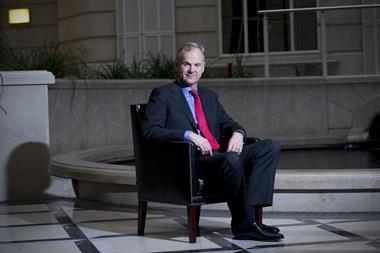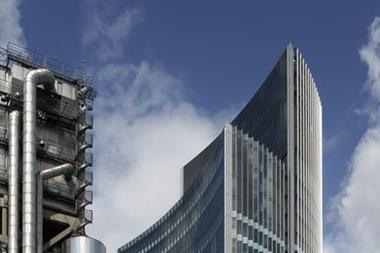Nathan Skinner visits the giant Heineken brewery in Amsterdam and talks to Eric Bloem, the firm’s head of insurance
Network with other risk managers online
Join StrategicRISKs exclusive LinkedIn group
Strategic Risk met Heineken International’s group insurance manager, Eric Bloem, at the NARIM (Nederlandse Associatie van Risk en Insurance Managers) annual conference in Ermelo, Holland. There he had been presented with a prestigious award for risk management. The association had decided to reward Bloem but, when asked about it, he quickly stressed that it was Heineken’s award, not his.
Curious about why Heineken had been singled out for the award, we were delighted when Bloem invited us over to the Netherlands for a tour of its Zoeterwoude brewery on the outskirts of Amsterdam. This facility is the biggest brewery in western Europe, with eight production lines churning out millions of hecto-litres of beer a year.
Clearly reputation and security are key concerns for the Dutch drinks giant. Our tour could not take place without prior clearance and more than one security pass. Once inside the bottling hall, the air was humid and all around was a steady drone of clinking bottles accompanied by a strong aroma of hops.
Health, safety and automation Heineken’s history, explains Bloem as we toured the site, is intertwined with the local community. What started out as a small 19th-century local brewer over 140 years ago has grown into a worldwide business employing over 56,000 people. With 125 breweries in more than 70 countries, Heineken is the largest brewer and cider producer in Europe. The group owns and sells more than 200 international beers and ciders, including Amstel, Foster’s, Murphy’s, Newcastle Brown Ale, Strongbow and Tiger. Last year the company reported revenues of over €14bn and total assets worth more than €20bn. Net profits were a little over €1bn.
The most striking thing about Heineken’s flagship Dutch brewery is the scale of automation. Even the fork-lift truck drivers at the production hub are mechanical. They are reminiscent of sci-fi monsters as they scoot silently across the factory floor, shifting huge stacks of beer off the production lines.
Automation allows Heineken to reduce its employers’ liability risk, but health and safety is taken very seriously. There is a library’s worth of safety and training manuals in the foyer. On an
elevated walkway, a full-length mirror reminds workers if they have forgotten to don ear guards, safety goggles or other personal safety measures.
Heineken has also done things to reduce the noise made by the bottles as they clink their way down the production line. Not only does this make the work environment safer, but it also improves the overall appearance of the bottles, by reducing superficial scratching.
Breweries are by no means immune to fire risk. One way Heineken manages this is by eliminating, as far as possible, the presence of combustibles in its facilities. The Zoeterwoude brewery is constructed virtually entirely from non-combustible materials like concrete and steel.
Says Bloem: ‘Irrespective of me, risk management is part and parcel of the daily activity of the firm. Risk management is a multifunctional discipline. It is not something that you can do alone.’
A recent scare occurred when 100 containers of product were damaged after a ship’s captain saw fit to steam head-on into a gale rather than forego his delivery deadline. Although the incident ended in a major loss, Bloem explains that he learnt again how much risk management work is done throughout the company every day.
In this case it was the quality control department that packages product very carefully to minimise losses. Given the loss record, they did pretty well over the years, says Bloem. ‘The insurer visited the brewery and was impressed that we put so much effort into preventing damage,’ he says.
A natural fit
Bloem started his career at Heineken 30 years ago, when he was brought in to strengthen the insurance department in a specialist marine role. Over time the role evolved into the function of insurance manager for the Dutch operation. A few years later the role of group insurance manager was created and Bloem was the natural fit. His first objective was to organise cover at group level for major catastrophe risks such as hurricane, earthquake, fire and liability risk. He had to make sure that cover was in place according to the desired standard and in an efficient manner.
Later on, programmes like D&O, crime, marine, construction, employment practice liability and fiduciary followed suit. To support this process, two captives were established. Currently, the priority is to deal with employee benefits and fleets on a global scale as well.
‘I’m not a risk manager; I’m an insurance manager involved in risk management,’ Bloem says.
‘I am involved in different stages of the risk management process in different roles. I learn and advise about risk, design and purchase insurance programmes, and deal with claims.
‘It is terrific to be involved in this manner as it gives me all the know-how I need to structure the covers. In addition, the general experience I earn in the insurance market gives me the opportunity to give back to the internal risk management process.’
Key concerns
Currently, Bloem’s main gripes are the depleted stock of strong global insurers and the lack of urgency at which the market responds to new risks. The security of the financial market is one of the biggest challenges he currently faces. ‘The financial world is in turmoil and it has hit a lot of insurers hard. Will this be the trigger that turns the commercial insurance market?’ he asks.
He also expresses concern about the failure of credit rating agencies, but concedes that the market may have to stick with what it knows. ‘What are the alternatives?’ he shrugs. His way of dealing with the crisis is to control the accumulation of risks. ‘It is an old trick, but I use co-insurance to spread the risk across the market.’
Asked about other strategies he employs to optimise his portfolio, Bloem mentions risk retention. ‘The captive insurance company will never be able to carry all our risk entirely, but it is a powerful
supporting tool. It can take care of the high frequency losses.’ Moreover, he says, this risk retention supports the internal risk management process. It also helps his negotiation with the insurance market, because it makes Heineken a better risk.
The tour ends at Heineken’s international head office in Amsterdam, home to generations of the Heineken family. Inside, the historic Dutch town house looks like any other modern corporate HQ. The one exception, as you might expect, is a shiny bar serving Heineken lagers and beers. Sadly, but perhaps for the best, your correspondent did not have the chance to sink a lunchtime beer. The after-work-only drinking rule, another internal risk management control, saw to that. n
Postscript
Nathan Skinner is associate editor of StrategicRISK



















